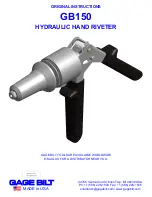
Changing the jaws
The jaws in your riveter are dirty or worn if you need to pull the trigger several times for the
riveter to work. The jaws may also be dirty or worn if they fail to grip the rivet pin when you pull
the trigger. In this case, you will need to replace the jaws.
1. Screw the frame head off by turning it anticlockwise using the spanner included. Remove
the whole frame head.
2. Loosen the jaw case. Lock the jaw case end using a 23 mm jaw spanner. Remove the
whole jaw case, making sure that the jaw case and jaw pusher do not jump out under
spring pressure.
3. Clean the jaws using a wire brush and mild detergent or similar. Replace the jaws if their
teeth are worn. Clean all of the parts thoroughly.
4. Drop a little oil on the round side of the jaws and insert them back into the jaw case.
Assembly
1. Mount the jaw case onto the riveter as above in reverse order, then tighten up all of the
parts.
2. Always check the gap between the jaw case front and end before use.
3. Hold the spanner gauge against the
assembled jaw case. The jaw case is correctly
assembled if the spanner gauge fits onto the
air hydraulic riveter as shown here. If not,
tighten or loosen the jaw case until you reach
the right gap width.
Lubrication
Pneumatic tools always require sufficient lubrication. The most reliable continuous way of
lubricating an air tool is by using a mist lubricator. However, the hose should not be more than
10 m in length if the lubricator is centrally mounted on the compressor or fastened to the end of
the compressed air tubing – the mist will dissipate in the air and the oil will begin to collect in a
longer hose before it can reach the tool itself.
Lubricator setting
Hose up to 5 m
Every 2 minutes
1 drop
Hose up to 10 m
Per minute
1 drop
If you do not own a mist lubricator, always add a few drops of oil onto the compressed air
connector before you use the tool. Lubricate the tool again after using it, especially if do not plan
to use the unit for an extended period. No other maintenance is needed.
Storage
•
Keep the tool indoors in a dry place protected from dust and dirt at temperature between
10 and 30°C.
•
Store the tool out of the reach of children and persons that require supervision.












































